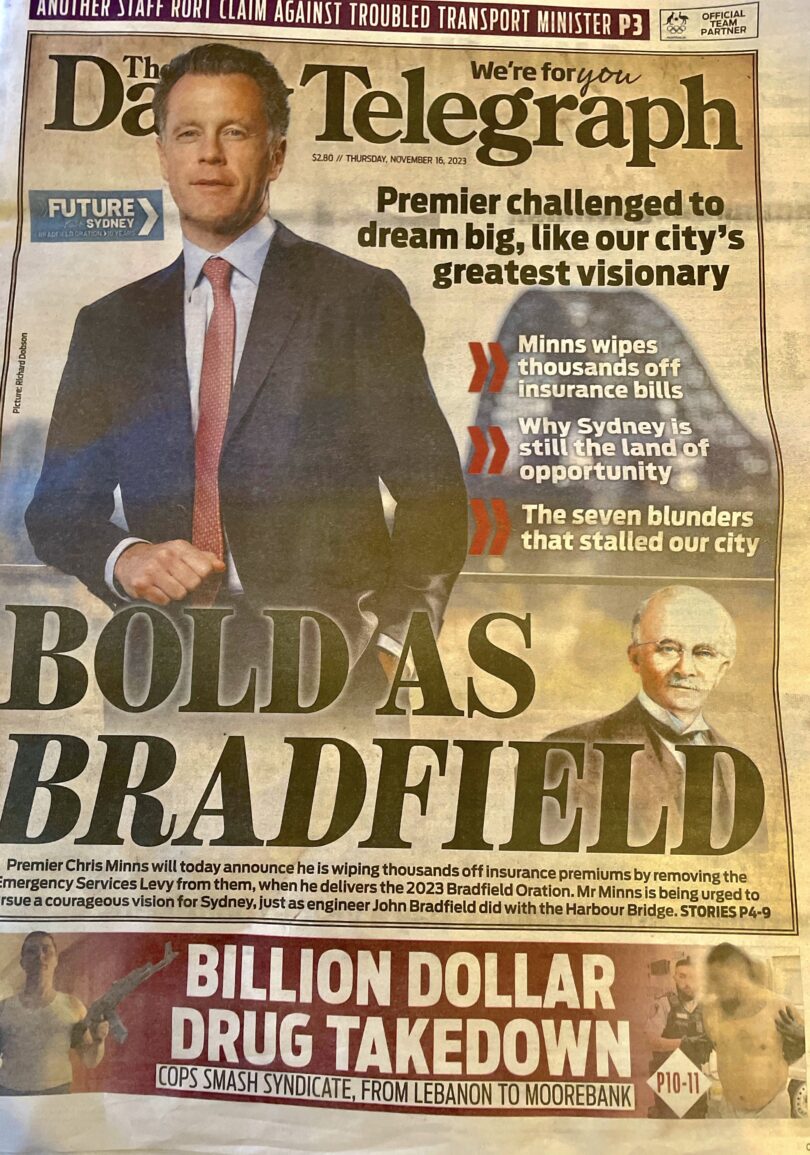The Daily Telegraph’s Future Sydney: Bradfield Oration
Thursday, 16 November 2023
Thank you so much to the editorial team and journalists at The Daily Telegraph, to the chair of the Bradfield Board of Governors, Tony Shepherd, to the former Editor of the Telegraph who came up with the idea for this address ten years ago, Paul Whittaker, thank you so much for the invitation and the honour of addressing today’s event.
To my colleagues, including the Deputy Premier of New South Wales Prue Car, Treasurer Daniel Mookhey, and Ministers Scully and Jackson.
I’d like to also acknowledge the traditional owners, the Gadigal people – and I also want to thank the MCA for hosting us today at this wonderful, beautiful venue right on the border of the most beautiful harbour on earth.
It’s a great honour to be invited to give the Bradfield Oration, an event that has become a major fixture on the annual calendar of our state.
And watching that video before Ben’s address and seeing Lucy Turnbull launching the three cities plan a few years ago, and then Dom trumping it with his six cities plan a few years later, I wanted to scoop the pool and announce 12 cities today, but I won’t; I resisted the urge.
But in all seriousness, the address is an opportunity to lay out the plans and ideas for a great city and to do it in front of influential leaders in our civic life.
In the past this address has been a platform to debate infrastructure, roads, urban growth, planning, public transport, taxes, as well as the intangible characteristics of a city. They’re difficult to identify – things like culture, and experience and the temperament of a city.
All of those contributions, sometimes at odds with one another, have been used to lay out competing visions about what’s possible, what to avoid and what we’re collectively missing out on in this beautiful city.

I’ve noticed in the past that the keynote speakers and some panelists at this address have been split in the past into two groups: those who are in Government, and are responsible for the executive leadership of the state or the country, and those who aren’t that are looking in from the outside.
The outsiders – are far freer to offer ideas without price tags attached, without any real regard to timelines or already commenced projects or contracts or budgets.
And I should know! That’s what I did last year as the leader of the opposition!
But all contributions rest on a simple premise: that this is a great city, filled with wonderful people who were either born here, or moved here to make a better life for themselves and their families.
And it’s the greatest city on Earth.
Wherever you end up with your designs for Sydney’s future, you start with a city that is bordered on the east with world class city beaches, on the west, north and south by some of the most pristine and awe-inspiring national parks in the world and a city that is intersected by three beautiful rivers that cut through the urban landscape offering in the process water access to literally millions of people.
It’s possible in Sydney to catch a wave at Maroubra, Cronulla or Manly BEFORE getting to work on a Friday morning.
It means wherever you live in Sydney – in all but one direction, and that’s east – you can travel 40 minutes and be in complete isolation in the middle of the natural beauty of a pristine national park.
And in the middle of it all is a deep harbour where a 30-storey cruise ship can pull up next to a 70-storey tower and then gently slip back into the spillway and then back out to the ocean.
So, in spite of my recent public support of the Brisbane Broncos in the NRL Grand Final, I can assure you that I, like you, absolutely love this city.
Friends, who are we up against in competition with this city?
Melbourne?
What can Melbourne genuinely offer?
It seems to be if you listen to Melbournians a mix of quote “Check out our coffee lanes” and some kind of “Parisian feel”.
Except that it doesn’t have the Louvre, it doesn’t have Haussmann architecture, it doesn’t have Bonaparte Boulevard’s, it doesn’t have the Musee d’Orsay, it doesn’t have the Eiffel tower.
In other words – it’s Paris, without any of Paris’s landmarks but with Paris’s alleyways.
However, when it comes to Sydney, all of that natural beauty creates natural limits to our vision for this town.
Those National Parks on all sides mean that we’re hemmed in when it comes to growth.
The rivers cut through Sydney like a scythe, and the city beaches/coastline mean that the eastern approach to the city doesn’t really exist – so unlike a lot of cities around the world who are big metropolises, it’s not possible for us to have ring roads with multiple access points to our downtown.
The second, and perhaps equally important, problem is that because of its natural beauty I think there’s a temptation to treat it like a masterpiece and let it hang in a museum untouched.
A precious artifact that’s just too delicate to mess with.
Afterall, you wouldn’t add an extra ab to Michelangelo’s David – and you wouldn’t add another lily pad to a Monet masterpiece.
But treating Sydney like a delicate object risks robbing its future – it’s akin to leaving it on an art gallery wall simply gathering dust.
It is a living thing this city, and just as Bradfield’s Harbour Bridge or Utzon’s Opera House were additions to the city that ultimately made it even more attractive, we can’t be afraid to make change that will add – and not subtract – from its beauty.
In short: we’ve got to have the confidence to make change in our city.
I believe that change must include at its heart new housing and density for the people who live here.
Housing is the key to ensure that young Australian’s have the ability to live and write the next chapter of Sydney’s future.
If we fail to do that then we won’t be providing to the next generation with the chance to grab a piece of Sydney for themselves, which many in this room (including me) were able to inherit or grab for themselves.
When I was young and graduating from high school, the key question my friends and I asked each other upon graduation was: “Will we ever be able to afford to buy a house in Sydney?”
The question for many these days is “Will I even be able to afford to rent a place here?”
It was at this speech last year, in the run up to the NSW election in March, where my party was able to clearly state that development had slowed to a crawl in Australia’s largest city.
And that the maze of planning agencies, bureaucracies and departments were hampering NSW competitiveness and also its ability to attract and retain capital in our state.
I was given the opportunity in Opposition to make that case alongside then Premier Domenic Perrottet.
And can I take the opportunity to congratulate Ben English for discontinuing the practice of inviting the Leader of the Opposition to these addresses.
No need to do it, Ben, no need to do it.
This forum was an opportunity to firmly say – supply – or in this case a lack of supply – was the leading reason for the housing affordability disaster in NSW and that something needed to be done about it.
Supply is fundamentally being hampered by excessive delays in processing development applications.
Currently local councils on average take 111 days to process a development application.
Across councils, this number varies. So, Blacktown has it down to ten weeks to process an application, while at Woollahra and Georges River council, it’s currently over 200 days.
That Bradfield debate, and the subsequent election campaign, around the need for the supply of housing went a long way in skewering the list of, what I call, red-herrings often prosecuted by NIMBY’s, anti – development Mayors and others who hope to draw our attention away, and hopefully frustrate attempts to build more opportunities for building in Sydney.
But the truth is there’s just no short cuts to a growing city.
I know, having appeared at this forum as Leader of the Opposition that it is a lot easier calling for these changes – rather than actually delivering them from Government.
Consequently I, rather than Domenic Perrottet, who I think is here today, am now on the hook to get development and completions going in this state.
Last year NSW had 48,000 housing completions in a 12-month period. Now you put that against Victoria that managed to achieve 59,000 in the same period of time.
NSW produces 6 houses per 1000 people, every 12 months. Victoria produces 8 and Queensland a massive 9 houses per 1000 people every single year.
So that means that despite having the largest population, the largest expected increase in population, the highest rents and the highest medium house prices, we are last on the East Coast when it comes to housing completions.
Our departments, our councils, some State MPs are saying “No” too often when it comes to new housing options for Sydney.
Every time they say “No” it means that another house will not be built for a young family, a single person, or a renter in our city.
For some assessors … “No” is the safest answer you can give…. After all, no one has ever been fired for rejecting a development application.
In other circumstances applicants and builders are being asked to repeatedly fund independent reports on shadowing or traffic management that is well over and above what was originally required for the development application.
That culture has to change.
And I know that the Minister for Planning who is here today, is determined to change that culture.
I want to say, Paul and I, as a starting point, the NSW Government will hold ourselves to be totally transparent about how we’re meeting this challenge.
The Government will publish housing approval times, or delays, for every State Significant Development – every single one of them.
We’ll also centralise and publish the average number of days it takes for all Council’s to turn around a Development Application and make that easily readable for the Daily Telegraph and other media organisations.
We’ll also publish housing completions in comparison to other States – a form of league table. So the citizens of New South Wales can track completions across borders and compare it to New South Wales.
This will ensure that the public are aware of the progress that Councils and the NSW Government are making when it comes to our goal of increasing housing supply and cutting red tape – but perhaps more importantly – the Government will be aware that the community is watching.
I want this question to weigh on the shoulders of my Ministers and senior public servants and senior Mayors– and that is – will I say no to this development – knowing that it will mean one less house for a young family to call Sydney home?
In the coming period the Government will publish plans for new housing zones that will allow greater uplift for infill development near major train and public transport hubs.
These new housing zones will allow for greater height and more housing, they will be strategically located to allow Sydney to grow.
However, not all of the housing required in New South Wales will come about as a result of high rise or new housing estates on Sydney’s fringe.
There was once a thriving development that was oriented in the middle ring of suburbs allowing more housing without the need for skyscrapers or traffic problems on local streets.
These were classic Sydney terraces and 3 and 4 story unit and apartment blocks.
It’s commonly referred to as “the missing middle” of housing development.
These projects, once common, have effectively been defined out of existence by years of planning and zoning restrictions from local Mayors and Councillors.
And this is a fact, only 2 of 32 local environment plans across Sydney currently allow for terraces and 2 storey unit blocks in areas zoned for low density residential.
2 out of 32.
Now this type of building is essential if we’re going to meet our housing targets. And it’s been essential in the past in spurring development and allowing many first home buyers to purchase their very first property.
It’s also a great building option for small scale builders to jump from working on free standing residential houses to greater density dwellings – without taking on the complexity and onerous nature of a big, tall residential tower.
The Building Commissioner, David Chandler, tells me we are desperate for this tier of developer to enter the market and start completing constructions.
Of course, David’s work over the past few years in the NSW building industry has been tireless and thorough – the Government will continue to support him and his team as the state constructs the housing required to confront the crisis.
But in order to get terraces and low-rise apartment blocks into the system sooner– I can announce today that the Government will launch a pattern-book development pathway for terraces and mid-level apartment buildings.
Working with industry, the Government Architect will develop several template building designs.
If a builder builds to the “pattern-book”– then the development will be considered complying development – it will be given an immediate tick.
The pattern book – standard design – will offer ease of approval, ease of construction, it will limit bespoke drafting or architectural plans, and it will mean cheaper component parts – as manufacturers will supply specs of the book – knowing that there’s a market that’s already been created, by the creation of this pattern book.
But…
…. We must make sure the pattern that we choose is beautiful, modern, and eventually beloved by Sydneysiders wherever they’re built.
And we also want to bring the community along.
With that in mind – I can also announce today that the Government will launch an international design competition for a budding young architect to design Sydney’s new terraces and Sydney’s new apartment blocks.
We want Australia and the world’s best young architects to put in a nomination, to show us your creativity and ideas for a structure our city will fall in love with.
When Premier Joe Cahill launched his competition for the design of the Sydney Opera House – he charged 10 pounds for registration – I haven’t told the Treasurer this, but we’ve waived the fee for all inbound competition entries.
But in all seriousness, this is your chance to design, not just a single building, but fundamentally change this city – for a young architect it’s literally a once in a lifetime opportunity.
The winning designs will be part of the pattern book.
For Sydney, it’s an opportunity to pick a design that we can shape around our city. Rather than boring uniformity – this will allow builders to pick the standard design they know is attractive, they know is great for the market and they can get going with almost immediately.
While we’re going to engage pattern book designs for both mid-rise apartment buildings and new terraces, when it comes to high-rise in well-located sites best suited for greater density, the Government is going to provide developers with options.
We have listened to feedback that site-specific competitions for every development is adding more than a year to the planning of any large DA.
Instead, developers of high-rise will be able to select an architect from a pre-approved list from the Government Architect.
This will turn off the need for the architect competitions on every single development and we believe slash approval time by up to 12 months.
If we see in the new high-rise developments the design quality we’re seeking, we’ll consider this for all high-rise developments.
I’ll have more to say about these sites in the near future, but I want these kinds of measures to be my Government’s hallmark in addressing the housing crisis – slashing approval times and costs to get great results for the people of the state.
The last several years – I need to say – the last several years our great state has been hit with an unprecedented level of natural disasters.
Across the Black Summer bushfires of 2019-2020 to the La Nina floods of 2021-22, to more than – where more than 30 residents of NSW lost their lives.
NSW lost more than 8,000 homes directly to fire and flood during that period.
Infrastructure losses totalled more than $4 billion.
Now experts tell us that with climate change we can expect more, not less, extreme weather events over the coming years.
That means more floods, more bushfires, more damaging storms, more extreme heat for Western Sydney and our regions.
I need to tell you that in 2023, the total funding for Fire and Rescue was $1.1 billion – and that was just for a single year.
The RFS –$800 million annually.
The State Emergency Service is over $400 million.
Funding for these three emergency services is 19% higher than it was in 2022, and a massive 75% bigger than it was in 2016.
The New South Wales Treasury expects the costs of natural disasters to increase from $5 billion in 2020 to at least $15-16 billion (in real dollars) by 2060.
So as you can see, these costs are astronomical and climbing and are funded by the fact that New South Wales is the only state in Australia to fund its emergency services by taxing insurance.
This tax on insurance means that our state has the second highest average rate of insurance for businesses and households between – after hurricane-prone Queensland.
It represents a massive disincentive to taking out insurance.
And at a time when the incidence of natural disasters is increasing and the costs of recovery are blowing out, this state has the highest proportion of uninsured homes of any jurisdiction in the county at 17 and a half per cent.
To put that in perspective – Victoria’s uninsured rate is just 11 per cent and South Australia’s, single digits at just 9 per cent.
The bottom line is we need households and businesses to take out insurance.
When a natural disaster hits – put frankly – the state does not have the funds to fully ensure a city or suburb is reconstructed without those businesses in that town taking out insurance.
As bad as the situation is today, worryingly 70 per cent of households report that affordability is the main barrier to having adequate home insurance cover for their house, and 9 per cent of households who are insured today intend to decreasing their insurance or getting rid of their policy altogether in the next 12 months.
This state’s tax on insurance throws up this perverse incentive whereby the tax on insurance becomes too expensive, therefore fewer people take our insurance, therefore the cost of insurance increases and is borne by an even smaller number of insurance holders who have to pay even more. And then the cycle is repeated over and over again.
The situation is also bad for business.
According to Business NSW with their ‘business conditions survey’ in May, the cost of insurance is the leading reason – is the number one concern, sorry, for businesses in New South Wales today.
The reason for that is that the cost is 14 per cent up over the last 12 months, nearly triple the rate of inflation – and faster than both energy and housing.
Now there’s a well-known joke about a tourist in Ireland who asks one of the locals for directions to Dublin.
And the Irishman replies: ‘Well sir, if I were you, I wouldn’t start from here’.
We’re determined to do something about it, notwithstanding the fact that this is where we are.
So, I can announce today that the Government will remove the Emergency Service Levy from insurance and apply it instead to property in the state.
This is in recognition that natural disasters affect everyone in NSW, and there’s a collective benefit in having fully-funded, well-prepared, well-resourced emergency services.
The New South Wales Treasurer, Daniel Mookhey, will lead consultation with industry and stakeholders on this important reform. And we will, of course, ensure adequate time to design the system that is both fair and workable.
But the changes will have the following principles.
Number one: There will be an insurance monitor established to ensure that those companies, those insurance companies, do not keep insurance high once the tax has been removed – and heavy penalties will apply to any that do.
The state will NOT collect a single extra dollar as a result of the changes – it will be completely revenue neutral.
We’ll learn the mistakes of the previous Government’s attempts at this reform and ensure that we are investigating all potential methods of measuring the value of a property not just the unimproved value of the land.
And, like other states, there will be protections inserted for pensioners who may not currently pay insurance on their property.
Until the model has been finalised, I can’t give an exact figure on how much a typical family will benefit as a result of this change, other than to say a mortgage holder – who must pay insurance as a condition of their loan – will pay less under these changes.
And we believe this is fair for households, and we believe it’s good for businesses.
After all, the fire engine turns up to your address whether or not you’ve taken out insurance – as it should – and the Government completely understands that it’s not as if anyone has elected to opt out of paying for fire protection.
But with more natural disasters on the way, we need a sustainable model that can have us prepared for an uncertain future, prepare us for increased business investment and opportunities for Australian firms, firms from interstate, and businesses from around the world who we want to do business right here in NSW.
Friends, two night ago – two nights ago, I had dinner with Erez the owner of Shaffa restaurant in Surry Hills.
You may have read about his restaurant in the media – someone spread and sprayed horrific anti-semitic graffiti on the front of his bar.
Erez is an amazing man.
He moved to this country from Israel eight years ago. He’s got an Argentinian wife, Clara, and a beautiful young boy named Timo.
He put his life savings into that restaurant, as well as his heart and soul and every available working minute.
It’s a remarkable thing to see someone put everything they’ve got into a business on the other side of the world.
But that’s the exactly the kind of people we attract to this beautiful city.
Two things struck me about my conversation with Erez.
Firstly, he was understandably in despair after hearing that vandalism and naked anti-semitism had been sprayed across the front of his business –he believed that no one would want to go to a restaurant that had been targeted with that kind of offensive filth. He was amazed to discover that the exact opposite thing happened.
The next night the restaurant was packed, his city rallied behind him, bookings stacked up, and those who couldn’t get a table bought a gift certificate instead.
Secondly, hearing Erez’s love for Sydney; his absolute astonishment at its beauties – which is undiminished even in the face of that despicable act of public racism.
It struck a chord with me. Sometimes it can take someone who wasn’t born and raised here to show us the city they they’re seeing through their eyes to understand what we live in each and every day.
My Government wants Sydneysiders to fall in love with this city all over again.
But I’m convinced only change – thoughtful, considered, and lasting – big and small – but change itself will help us do just that.
From major infrastructure projects, to subtle changes that benefit the culture, to making much-needed and long-overdue tax reform.
Change, as much as our natural beauty, is what makes Sydney great.
So, together, lets grasp the opportunity and live up to the daunting legacy of the ultimate change-maker in our city’s history, Dr John Bradfield.
Thank you so much everybody.
MEDIA: Dan Conifer | Premier | 0456 723 037






